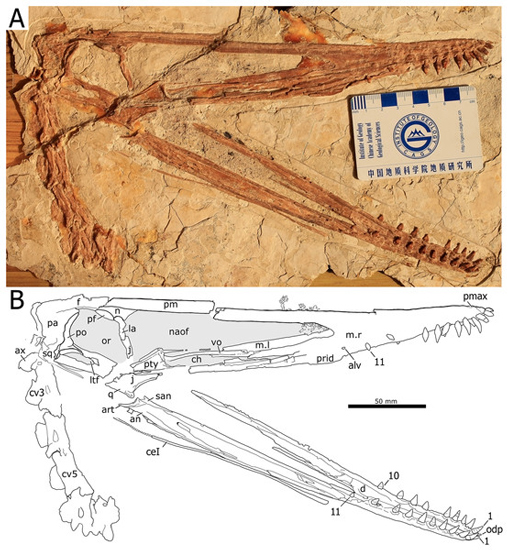Nurhachius luei – A New Species of Early Cretaceous Pterosaur from China
A team of international researchers including scientists from the Chinese Academy of Sciences, the University of Copenhagen and the Fur Museum (both Denmark), along with colleagues based in Brazil, have named a new species of istiodactylid pterosaur from the Liaoning Province of north-eastern China. This new flying reptile has been named Nurhachius luei, it is the second species in the Nurhachius genus to be announced after the type species Nurhachius ignaciobritoi, which also hails from the Jiufotang Formation, was named and described in 2005.
The Holotype Specimen of Nurhachius luei
Picture credit: PeerJ
Pterosaur Species Described from Cranial Material and Neck Bones
More than twenty different pterosaur species have been described to date from fossils associated with the Jiufotang Formation of China. Although, the date of these extensive deposits is controversial, it is thought that Nurhachius luei lived during the Aptian faunal stage of the Cretaceous (125 – 113 million years ago).
The Istiodactylidae family are thought by many palaeontologists to represent the first lineage of the Pterodactyloidea. They evolved sometime in the Late Jurassic and their thin bone walls, reduced tails, absence of a fifth toe and elongated hand bones (metacarpals), provided the anatomical “blueprint” for all subsequent types of pterosaur. In essence, these “new” types of flying reptile replaced the long-tailed rhamphorhynchids and their relatives.
Four pterosaur genera and five species (all represented by a single specimen), have been referred to the Istiodactylidae. Three of the genera are associated with Liaoning deposits, whilst the remaining genus Istiodactylus (I. latidens), the first to be studied at the very beginning of the 20th century, hails from the Early Cretaceous Vectis Formation of the Isle of Wight.
Nurhachius luei
A few years ago (2011), a jaw tip found in Canada was interpreted as being from an istiodactylid pterosaur. This pterosaur was named Gwawinapterus beardi. It seemed both geographically and temporally removed from all the other known members of the Istiodactylidae and a revised description was published in 2012. Gwawinapterus was actually a fish, it just happened to have closely spaced teeth that superficially resembled the dentition of istiodactylid pterosaurs.
To read more about Gwawinapterus beardi: A New, Unique Species of Canadian Pterosaur is Described.
The scientific paper: “Nurhachius luei, a new istiodactylid pterosaur (Pterosauria, Pterodactyloidea) from the Early Cretaceous Jiufotang Formation of Chaoyang City, Liaoning Province (China) and comments on the Istiodactylidae” by Xuanyu Zhou, Rodrigo V. Pêgas, Maria E.C. Leal and Niels Bonde published in the academic journal PeerJ.
For pterosaur models and figures: The Everything Dinosaur Website.







Leave A Comment